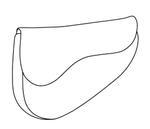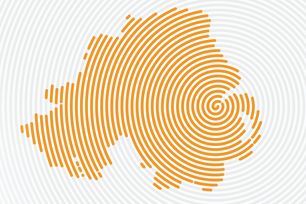Back in the saddle
R 32/2022-2, Christian Dior Couture (Appeal), EUIPO, 5th October 2022.

Sector norms were at the heart of a rejection, says Felicity Hide
Key points
- The bar for registration of shape marks remains high
- In design-focused sectors, it may be difficult to establish a departure from the norm

By means of a recent decision of the Second Board of Appeal of the EUIPO, the Dior saddle bag takes its place in a long line of shape marks rejected under Article 7(1)(b) of the EU Trade Mark Regulation, in that the mark was considered inherently devoid of distinctive character.
Dior filed in 2021 to register the “saddle bag” shape, with goods claimed being, not surprisingly, bags, but also a range of other leather goods in class 18, and sunglasses, spectacles and cases in class 9.
By 2021 Dior’s saddle bag was well established on the luxury market.
It was designed by John Galliano and launched in 1999, and variants of the shape have been used ever since by Dior.
In keeping with the prestige of the Dior mark, consumers pay a high price for one of these bags, a point that came up before the Board of Appeal (BoA).
However, to deal first with the original objection, the Examiner at first instance stated that the Dior bag wasn’t significantly different from other bags on the market and pointed out that bags come in a huge range of shapes – from rectangular to oval, long to wide, with or without a flap, with zipper or with buttons, and so on.
The list given was not meant to be exhaustive but did provide an indication of the diverse market within which the Dior bag had to stand out in order to be accepted for registration.
Indeed, the legal test was whether the shape was so materially different from the state of the market that it was a “significant departure from the norms” of the sector concerned.
The Examiner found that the Dior bag would be perceived merely as a variant of the shapes already on the market, and not a significantly different variant.
Tests for distinctiveness
As an interim step of the appeal, the BoA’s Rapporteur pointed out to Dior several bags already on the market. Dior’s response encompassed not only the bags found by the Rapporteur, but a range of other points, each of which was dismissed in turn by the BoA. It gave the usual tests for assessing the distinctiveness of a shape mark, namely:
- The criteria for shape marks are no different; however, the perception of the relevant public isn’t necessarily the same for a shape mark.
- Consumers aren’t in the habit of making assumptions on the origin of products due to their shape and so it could prove more difficult to establish distinctive character for a shape mark than for a word or figurative mark.
- Only shape marks which represent a significant departure from the norms of the relevant sector are likely to fulfil the required origin function.
Dior argued that the relevant public would pay a high degree of attention to the shape in question because this is a luxury product with a high price point.
By contrast, the original examination report had stated that the consumer’s degree of attention would be “average to high” and would vary according to the price level of the product.
The BoA agreed and found that the relevant public couldn’t be reduced to those purchasing luxury goods only: bags and leather goods (as listed in the description of goods) are found in a range of shops from supermarkets upwards, and all of those consumers must be taken into account.
Not a significant departure
The “norms of the sector” appear to be at the heart of this case and the BoA stated that these couldn’t be reduced to the most usual shapes of bags, but that all bags that consumers were used to seeing were relevant.
It appears that this is where the facts of the case diverged from the Guerlain Rouge G lipstick case (T‑488/20). In the Guerlain case, the market for lipsticks showed a more restricted variety of cylindrical or oblong shapes and Guerlain successfully registered its rounded lipstick case shape.
However, here the BoA pointed out that for bags there were “a multitude and abundance of forms to which the public is regularly exposed” (paragraph 19). Set within this multitude, the Dior saddle bag wasn’t a significant departure from the norm.
This does appear to be a rather over‑inclusive view of what the norms of the sector are. Even if bags exist that are shaped, say, like penguins, that need not mean that a penguin‑shaped bag is normal.
The BoA seems to indicate that any bag on the market forms part of the variety of “norms” of the sector, and within that context it seems practically impossible for the Dior bag – or indeed a bag of any shape – to be a significant departure.
The examples found by the Rapporteur ought not, in this writer’s view, to have been fatal to the Dior case: there are examples of almost anything on the internet, but that doesn’t make each and every example “normal”.
Only one of the Rapporteur’s examples seemed to resemble the Dior shape, and it is entirely possible that it was itself inspired by the original Dior bag.
Dior provided ample evidence regarding its own use of its bag, but that evidence was in relation to the secondary claim to acquired distinctiveness, and not to the norms of the market for the purpose of the absolute grounds objection.
In the context of this wide design freedom relating to bags, the BoA rejected the appeal insofar as “bags; handbags; leather pouches; leather travel cases; toilette cases and make‑up cases” were concerned.
For those goods, the case goes back to the Examination Division for it to consider the acquired distinctiveness secondary claim.
For the remaining goods, Dior did secure registration, and these included sunglasses, spectacles and their cases in class 9, and suitcases and other leather goods in class 18.
It is interesting to note that for these accepted goods, the BoA was “not aware” of any such goods in a saddle shape (paragraphs 29 and 30).
Bearing in mind the earlier observation that the BoA was “not required to provide examples of identical products on the market” (paragraph 24) it seems odd that the Board’s Rapporteur actively researched bags but did not do so for the accepted leather goods.
It seems that the bar for securing registration for shape marks is as high as it ever was, perhaps higher. Within a design field where “anything is possible”, it seems from this case that both “everything is normal” and “nothing is a departure from the norm”.
Judgment published in French.





